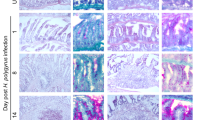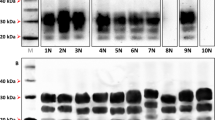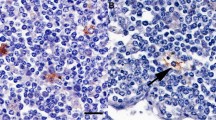Abstract
In transmitted prion diseases the immune system supports the replication and the propagation of the pathogenic agent (PrPSc). DCs, which are mobile cells present in large numbers within lymph organs, are suspected to carry prions through the lymphoid system and to transfer them towards the peripheral nervous system. In this study, C57Bl/6 mice were orally inoculated with PrPSc (scrapie strain 139A) and sacrificed at the preclinical stages of the disease. Immunolabelled cryosections of Peyer’s patches were analysed by confocal microscopy. Membrane prion protein expression was studied by flow cytometry. In Peyer’s patches (PP), dissected at day one and day 105 after oral exposure to scrapie, we observed an increased population of DCs localised in the follicular-associated epithelium. On day 105, PrPSc was found in the follicles inside the PP of prion-infected mice. A subset of Peyer’s patches DCs, which did not express cellular prion protein on their surface in non-infected mice conditions, was prion-positive in scrapie conditions. Within Peyer’s patches oral scrapie exposure thus induced modifications of the homeostasis of DCs at the preclinical stages of the disease. These results give new arguments in favour of the implication of DCs in prion diseases.





Similar content being viewed by others
References
Amigorena S (2001) Exosomes derived from dendritic cells. J Soc Biol 195(1):25–27
Anjuère F, Luci C, Lebens M, Rousseau D, Hervoet C, Milon G, Holmgren J, Ardavin C, Czerkinsky C (2004) In vivo adjuvant-induced mobilization and maturation of gut dendritic cells after oral administration of cholera toxin. J Immunol 173(8):5103–5111
Antoine N, Cesbron JY, Coumans B, Jolois O, Thellin O, Zorzi W, Heinen E (2000) Differential expression of PrPc in human blood and tonsil lymphocytes. Haematologica 85:475–480
Aucouturier P, Geissmann F, Damotte D, Saborio GP, Meeker HC, Kascsak R, Kascsak R, Carp RI, Wisniewski T (2001) Infected splenic dendritic cells are sufficient for prion transmission to the CNS in mouse scrapie. J Clin Invest 108(5):703–708
Bacot SM, Lenz P, Frazier-Jessen MR, Feldman GM (2003) Activation by prion peptide PrP106-126 induces an NF-kappaB-driven proinflammatory response in human monocyte-derived dendritic cells. J Leukoc Biol 74(1):11–25
Banchereau J, Briere F, Caux C, Davoust J, Lebecque S, Liu YJ, Pulendran B, Palucka K (2000) Immunobiology of dendritic cells. Annu Rev Immunol 18:767–811
Beringue V, Demoy M, Lasmézas CI, Gouritin B, Weingarten C, Deslys JP, Aderux JP, Couvreur P, Dormont D (2000) Role of spleen macrophages in the clearance of scrapie agent early in pathogenesis. J Pathol 190:495–502
Blattler T, Brandner S, Raeber AJ, Klein MA, Voigtlander T, Weissmann C, Aguzzi A (1997) PrP-expressing tissue required for transfer of scrapie infectivity from spleen to brain. Nature 389(6646):69–73
Bolton DC, Bendheim PE (1991) Purification of scrapie agent: how far have we come? Curr Top Microbiol Immunol 172:39–55
Brown KL, Stewart K, Ritchie DL, Mabbott NA, Williams A, Fraser H, Morrison WI, Bruce ME (1999) Scrapie replication in lymphoid tissues depends on prion protein-expression follicular dendritic cells. Nat Med 5:1308–1312
Bueler H, Aguzzi A, Sailer A, Greiner RA, Autenried P, Aguet M, Weissmann C (1994) PrP-deficient mice are resistant to scrapie. Ann NY Acad Sci 724:235–240
Burthem J, Urban B, Pain A, Roberts DJ (2001) The normal cellular prion protein is strongly expressed by myeloid dendritic cells. Blood 98:3733–3738
Carp RI, Callahan SM (1981) In vitro interaction of scrapie agent and mouse peritoneal macrophages. Intervirology 16:8–13
Cavanagh LL, Von Andrian UH (2002) Travellers in many guises: the origins and destinations of dendritic cells. Immunol Cell Biol 80(5):448–462
Chabot S, Wagner JS, Farrant S, Neutra MR (2006) TLRs regulate the gatekeeping functions of the intestinal follicle-associated epithelium. J Immunol 176:4275–4283
Cook DN, Prosser DM, Forster R, Zhang J, Kuklin NA, Abbondanzo SJ, Niu XD, Chen SC, Manfra DJ, Wiekowski MT, Sullivan LM, Smith SR, Greenberg HB, Narula SK, Lipp M, Lira SA (2000) CCR6 mediated dendritic cells localization, lymphocyte homeostasis, and immune responses in mucosal tissue. Immunity 12(5):495–503
Defaweux V, Dorban G, Demonceau C, Piret J, Jolois J, Thellin O, Thielen C, Heinen E, Antoine N (2005) Interfaces between dendritic cells, other immune cells and nerve fibers in mouse Peyer’s patches: potential sites for neuroinvasion in prion diseases. Microsc Res Tech 66(6):1–9
Denzer K, Kleijmeer MJ, Heijnen HF, Stoorvogel W, Geuze HJ (2000) Exosome: from internal vesicle of the multivesicular body to intercellular signaling device. J Cell Sci 113(19):3365–3374
Fallarino F, Asselin-Paturel C, Vacca C, Bianchi R, Gizzi S, Fioretti MC, Trinchieri G, Grohmann U, Puccetti P (2004) Murine plasmacytoid dendritic cells initiate the immunosuppressive pathway of tryptophan catabolism in response to CD200 receptor engagement. J Immunol 173(6):3748–3754
Fevrier B, Vilette D, Laude H, Raposo G (2005) Exosomes: a bubble ride for prions? Traffic 6(1):10–17
Ford MJ, Burton LJ, Morris RJ, Hall SM (2002) Selective expression of prion protein in peripheral tissues of the adult mouse. Neuroscience 113(1):177–192
Fraser H, Brown KL, Stewart K, McConnell I, McBride P, Williams A (1996) Replication of scrapie in spleens of SCID mice follows reconstitution with wild-type mouse bone marrow. J Gen Virol 77:1935–1940
Ghosh S (2004) Mechanism of intestinal entry of infectious prion protein in the pathogenesis of variant Creutzfeldt-Jakob disease. Adv Drug Deliv Rev 42(6):915–920
Gonzales L, Terry L, Jeffrey M (2005) Expression of prion protein in the gut of mice infected orally with the 301V murine strain of the bovine spongiform encephalopathy agent. J Comp Path 132:273–282
Heppner FL, Christ AD, Klein MA, Prinz M, Fried M, Kraehenbuhl JP, Aguzzi A (2001) Transepithelial prion transport by M cells. Nature 7:976–977
Huang FP, Farquhar CF, Mabbott NA, Bruce ME, MacPherson GG (2002) Migrating dendritic cells transport PrPsc from the gut. J Gen Virol 83:267–271
Huang FP, MacPherson GG (2004) Dendritic cells and oral transmission of prion diseases. Adv Drug Deliv Rev 56(6):901–913
Hugel B, Martinez MC, Kunzelmann C, Blattler T, Aguzzi A, Freyssinet JM (2004) Modulation of signal transduction through the cellular prion protein is linked to its incorporation in lipid rafts. Cell Mol Life Sci 61(23):2998–3007
Jeffrey M, McGovern M, Goodsir CM, Brown KL, Bruce ME (2000) Sites of prion accumulation in scrapie-infected mouse spleen revealed by immuno-electron microscopy. J Pathol 191:323–332
Kaneider NC, Kaser A, Dunzendorfer S, Tilg H, Patsch JR, Wiedermann CJ (2005) Neurokinin-1 receptor interacts with PrP 106-126-induced dendritic cell migration and maturation. J Neuroimmunol 158:153–158
Kelsall BL, Strober W (1996) The role of dendritic cells in antigen processing in Peyer’s patches. Ann NY Acad Sci 778:47–54
Klein MA, Frigg R, Flechsig E, Raeber AJ, Kalinke U, Bluethmann H, Bootz F, Suter M, Zinkernagel RF, Aguzzi A (1997) A crucial role for B cells in neuroinvasion scrapie. Nature 390:687–690
Koperek O, Kovacs GG, Ritchie D, Ironside JW, Budka H, Wick G (2002) Disease-associated prion protein in vessel walls. Am J Pathol 161(6):1979–1984
Li R, Liu D, Zanusso G, Liu T, Fayen JD, Huang JH, Petersen RB, Gambetti P, Sy MS (2001) The expression and potential function of cellular prion protein in human lymphocytes. Cell Immunol 207:49–58
Luhr KM, Wallin RP, Ljunggren HG, Low P, Taraboulos A, Kristensson K (2002) Processing and degradation of exogenous prion protein by CD11c(+) myeloid dendritic cells in vitro. J Virol 76(23):12259–12264
Luhr KM, Nordstrom EK, Low P, Ljunggren HG, Taraboulos A, Kristensson K (2004) Scrapie protein degradation by cysteine proteases in CD11c+ dendritic cells and GT1-1 neuronal cells. J Virol 78(9):4776–4782
Mabbott AN, Bruce ME (2001) The immunobiology of TSE diseases. J Gen Virol 82:2307–2318
Mabbott AN, McPherson GG (2006) Prions and their lethal journey to the brain. Nat Rev Microbiol 4:201–211
Ma B, von Wasielewski R, Lindenmaier W, Dittmar KEJ (2007) Immunohistochemical study of the blood and lymphatic vasculature and the innervation of mouse gut and gut-associated lymphoid tissue. Anat Histol Embryol 36:62–74
Maignien T, Lasmézas CI, Beringue V, Dormont D, Deslys JP (1999) Pathogenesis of the oral route of infection of mice with scrapie and bovine spongiform encephalopathy agents. J Gen Virol 80:3035–3042
Martinez del Hoyo G, Lopez-Bravo M, Metharom P, Ardavin C, Aucouturier P (2006) Prion protein expression by mouse dendritic cells is restricted to the nonplasmacytoid subsets and correlates with the maturation state. J Immunol 177(9):6137–6142
Morel E, Andrieu T, Casagrande F, Gauczynski S, Weiss S, Grassi J, Rousset M, Dormont D, Chambaz J (2005) Bovine prion is endocytosed by human entreocytes via the 37 kDa/67 kDa laminin receptor. Am J Pathol 167(4):1033–1042
Neutra M (1999) M cells in antigen sampling in mucosal tissue. Curr Top Microbiol Immunol 236:17–32
Niess JH, Brand S, Gu X, Landsman L, Jung S, McCormick BA, Vyas JM, Boes M, Ploegh HL, Fox JG, Littman DR, Reinecker HS (2005) CX3CR1-mediated dendritic cell access ti the intestinal lumen and bacterial clearance. Science 307:254–258
Prado MA, Alves-Silva J, Magalhaes AC, Prado VF, Linden R, Martins VR, Brentani RR (2004) PrPc on the road: trafficking of cellular prion protein. J Neurochem 88(4):769–781
Prinz M, Huber G, MacPherson AJ, Heppner FL, Glatzel M, Eugster HP, Wagner N, Aguzzi A (2003) Oral prion infection requires normal numbers of Peyer’s patches but not of enteric lymphocytes. Am J Pathol 162(4):1103–1111
Raeber AJ, Klein MA, Frigg R, Flechsig E, Aguzzi A, Weissmann C (1999) PrP-dependent association of prions with splenic but not circulating lymphocytes of scrapie-infected mice. EMBO J 18(10):2702–2706
Rescigno M, Urbano M, Valzasina B, Francolini M, Rotta G, Bonasio R, Granucci F, Kraehenbuhl JP, Ricciardi-Castagnoli P (2001) Dendritic cells express tight junction proteins and penetrate gut epithelial monolayers to sample bacteria. Nat Immunol 2(4):361–367
Rybner-Barnier C, Jacquemot C, Cuche C, Doré G, Majlessi L, Gabellec MM, Moris A, Schwartz O, Di Santo J, Cumano A, Leclerc C, Lazarini F (2006) Processing of the bovine spongiform encephalopathy-specific prion protein by dendritic cells. J Virol 80(10):4656–4663
Thielen C, Antoine N, Melot F, Cesbron JY, Heinen E, Tsunoda R (2001) Human FDC express PrPc in vivo and in vitro. Dev Immunol 8(3–4):259–266
Unterberger U, Voigtländer T, Budka H (2005) Pathogenesis of prion diseases. Acta Neuropathol 109(1):32–48
Wykes MN, Beattie L, MacPherson GG, Hart DN (2004) Dendritic cells and follicular dendritic cells express a novel ligand for CD38 which influences their maturation and antibody responses. Immunology 113(3):318–327
Zhao X, Sato A, Dela Cruz CS, Linehan M, Luegering A, Kucharzik T, Shirakawa AK, Marquez G, Farber JM, Williams I, Iwasaki A (2003) CCL9 is secreted by the follicle-associated epithelium and recruits dome region Peyer’s patch CD11b+ dendritic cells. J Immunol 171(6):2797–2803
Acknowledgements
This work was supported by the Région Wallonne and EU Research Immuno TSE project number QLK5-CT-2002-01044. SAF antibodies were kindly provided by Jacques Grassi, CEA Saclay, Gif-sur-Yvette. Scrapie strain 139 A was provided by Pierre Aucouturier, INSERM E209, Paris.
Author information
Authors and Affiliations
Corresponding author
Rights and permissions
About this article
Cite this article
Dorban, G., Defaweux, V., Levavasseur, E. et al. Oral scrapie infection modifies the homeostasis of Peyer’s patches’ dendritic cells. Histochem Cell Biol 128, 243–251 (2007). https://doi.org/10.1007/s00418-007-0303-9
Accepted:
Published:
Issue Date:
DOI: https://doi.org/10.1007/s00418-007-0303-9




